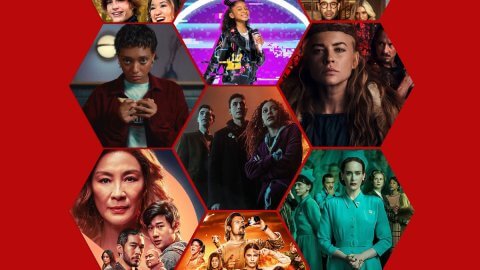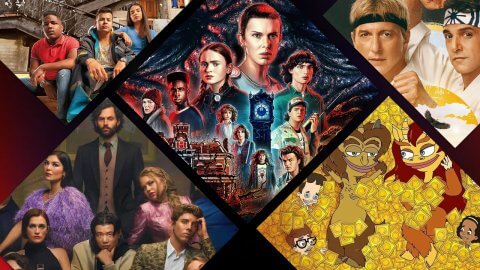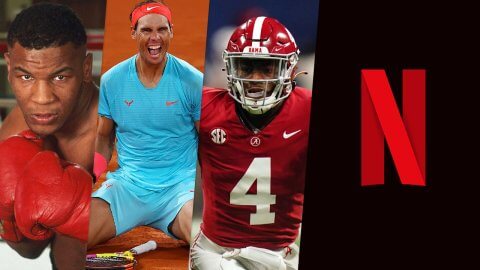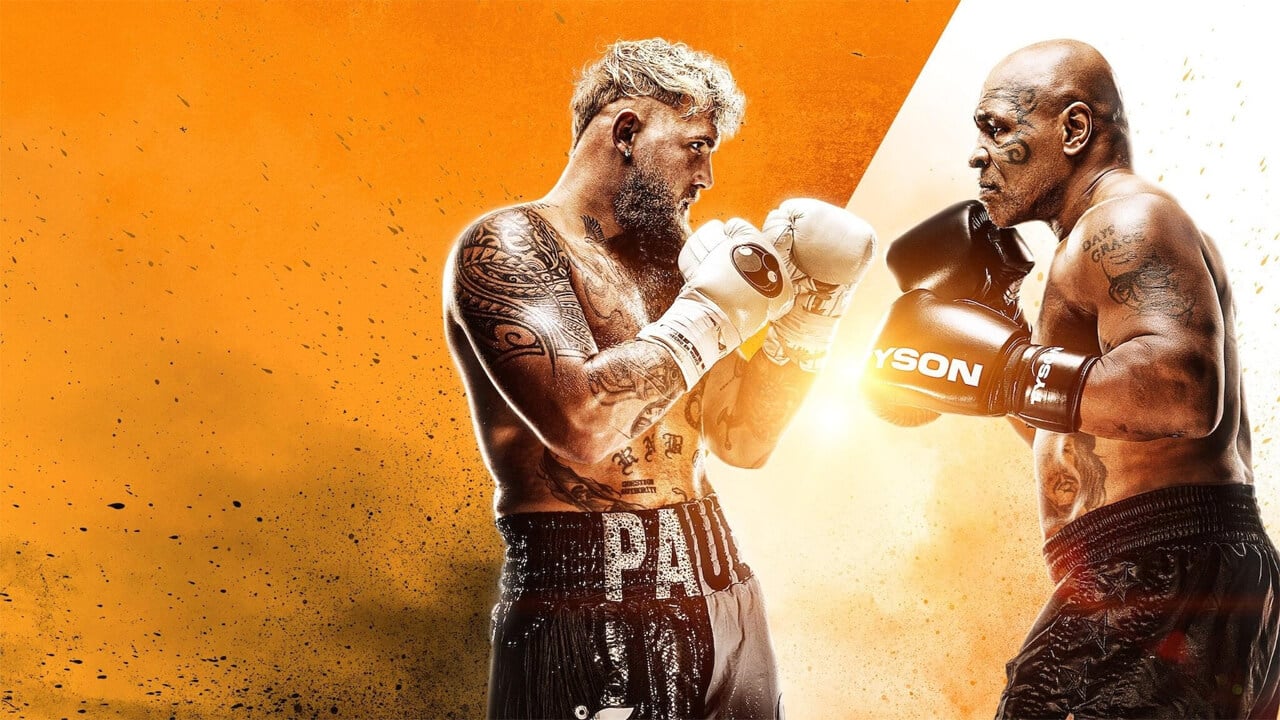
Picture: Jake Paul vs. Mike Tyson – Netflix
Jake Paul vs. Mike Tyson was the most streamed sporting event in history. Netflix’s three-part documentary Countdown: Paul vs. Tyson aided the hype and build-up for the fight. We enjoyed discussing the sports doc with its directors, Tim Mullen and Jackie Decker.
Countdown: Paul vs Tyson was the companion docuseries to Netflix’s biggest live event to date, Jake Paul’s showdown with Mike Tyson and the rematch between Katie Taylor and Amanda Serrano at the AT&T Stadium in Arlington, Texas.
Tim Mullen and Jackie Decker, multi-Emmy-Award-winning producers, directed the series, which offered audiences unprecedented inside access to Mike Tyson and Jake Paul’s training camps.
Jacob: How did you first become involved with Countdown?
Tim: That’s a great question. We’ve done a lot of boxing. I worked on the old 24/7s for HBO in the old days. Those evolved as HBO boxing went away, and then Showtime boxing took over through Steven Espinoza and David Dinkins. That crew had a show called All Access. We transitioned almost immediately into that show, and Jackie and I worked on those shows for years.
Jackie: Yeah, we’ve been executive producing, but it’s also a small crew. So we are producing, editing, everything, those shows for, I mean, what, Tim, probably eight years at this point?
Tim: Yeah, those went on for a while. We did a lot of those shows, and then when Showtime went away, PBC Boxing made a deal with Everwonder, the production company of record on Countdown, and that pretty much opened the door for Jackie and I. Then, Netflix came along with this idea for Jake Paul and Mike Tyson, and the folks at Everwonder, who we had just met through this other venue we were on a shortlist Netflix was recommending to be showrunners as we had just completed our season one of NASCAR [Full Speed] for Netflix. So, as we were on that shortlist, Everwonder was like, “Oh! We know Jackie and Tim, so that’ll be easy,” so pretty much overnight, we transitioned over to that.
Jackie: It was great, though, for us. I’ll say this: We had a formula with All Access back in the day and even the 24-hour docu sports follow shows. But when it came to Countdown, one thing that was great for us was that they gave Tim and me a lot of creative freedom, so let’s do things a little differently than what you’d typically get. So that is definitely why when you watch Countdown, it’s undoubtedly laced in the verite scenes of both guys. Still, it has a significant amount of history that we loved and wanted to tell because immediately we were like, Jake Paul’s fans don’t know who Mike Tyson proper is, and Mike Tyson’s fans don’t know who Jake Paul is. It was an excellent opportunity for us to open our wings a little bit and storytelling a different way from your typical hard knocks, that kind of like, you know, ways of docu-style sports shows.
Jacob: I did feel that the documentary had more of an intimate approach with Mike and Jake. It felt like I got to know both fighters more by the end of the third episode. With Jake being such a large personality, mostly known for his work on the internet and then his transition into boxing, it felt that at certain times throughout Countdown, we saw more of Jake, the person, than Jake Paul, the internet personality.
Jackie: I know when I speak for both Tim and I, that makes us super happy to hear that because I think authenticity is important for us whenever we go into a project. To make sure people come off as not only likable, not even just faking the likable, but seeing the genuine person in our characters and our athletes is crucial for us.
This is also the second time Tim and I have worked on a show with Jake. The first time it was an all access on Showtime for one of his earlier fights. We fell in love with him working on that show, and we were really excited for this bigger audience to get to know the real Jake.
You know, he is, at the core, just a really smart, intelligent entrepreneur and businessman. We always say the phrase like he just gets it. As TV people, he just gets it. Like, let’s send a crew out. We’ll do X, Y, and Z, and he’ll be down with all of it.

Picture: Jake Paul training for his fight with Mike Tyson – Netflix
Tim: We don’t have to walk him through stuff like a great example of that is the punch-out scene with Mike Tyson. With certain subjects that we deal with, you kinda have to walk them through the process, but with Jake, he’s like, “I got you. I know what you’re looking for here.” He’s so used to being on camera.
That was the big difference between Mike and Jake. If you ever watch Jake, he’s got eight to ten cameras on him at any given time, and if you put his brother Logan in the same room, that goes up to twelve cameras following those guys around at all times. Mike, who has never done a show quite like this, was a little more apprehensive about the number of cameras around. He was often a lot more elusive because he was not used to it. Mike’s never done a countdown-type twenty-four-seven all-access show before. But it was also fun easing him into the process and seeing how he got more comfortable with the crew we had sent out there. That’s the key with a guy like Mike, especially trying to keep the crew that we used small and consistent.
Jackie: Yeah. And to go back to your question, Jacob, with Jake, loves to play the villain, and admittedly so. I think it was really great that it came across that he isn’t necessarily an a-hole, that, for lack of a better phrase, and that he is truly, deep down, a good person. But when the cameras are on in certain scenarios, he knows how to turn it on. One of our journalists said that in today’s day and age, going viral is everything right now, whether or not it’s for the negative or the positive, and I think Jake sees that. He’s incredibly thoughtful about that.
Tim: And what he’s done for women’s boxing alone is incredible. He’s not wrong when he says who else has done that?
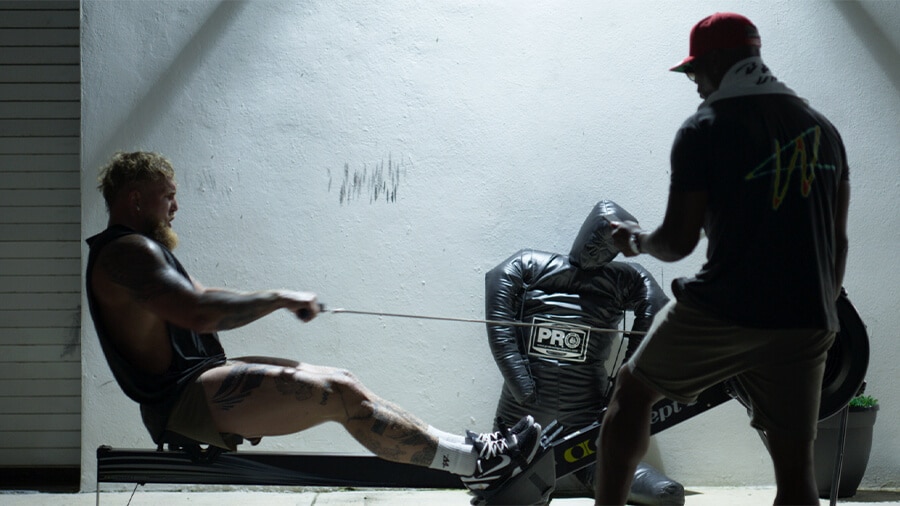
Picture: Jake Paul training for his fight with Mike Tyson – Netflix
Jacob: Well, that brings me to my next question. What was it like working with Katie Taylor and Amanda Serrano?
Tim: I was lucky enough to be in the room with both of them often, and I can honestly say they are probably two of the nicest people I’ve ever met. And again, they are also not used to having a show like this. It wasn’t that they were apprehensive, but they were probably just a little bit more nervous to have those kinds of cameras around. It actually made it difficult for us, because Jackie and I were at the fight, and you know, it was controversial at the end of it. So to hear the crowd bullying Katie was tough for us because I’m telling you, she is probably one of the nicest people ever, and the same goes for Amanda. They couldn’t be smarter and nicer. So the way that they are able to turn that off and become badasses in the ring is impressive because they are serious, but they like each other too, and there are no bad feelings between the two of them.
Jackie: They’re both super humble. I will say Tim and I have talked about this. If there isn’t a documentary just on those two ladies after this, I’d be shocked, especially if they run it back for a third time, which would be crazy not to. There’s much more to unpack in both of their stories.
They both have incredible backstories and even personal lives to this day. Boxing is literally both of their lives. All they do is train, so they would be a really great case study.
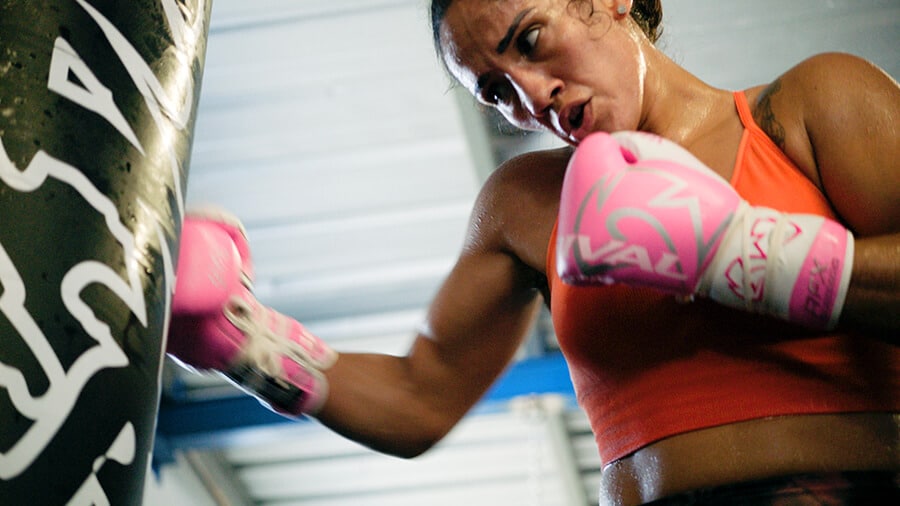
Picture: Amanda Serrano training for her fight against Katie Taylor – Netflix
Jacob: Countdown definitely left me wanting to learn more about Amanda and Katie.
Tim: That’s a win for us because you always want to leave your audience wanting more, not less.
Jackie: It’s true, and it was a fine line to weave when we were in the edit, too, just making sure that we were paying them off in a way that people were interested in. And it was a fine line to weave when we were in the edit, too, just making sure that we were paying them off in a way that people were interested in and digging it, and not making it a left turn.
They both had really great ties to Mike and Jake, so it was easier for us to do, but yeah, it was a fine line to walk.
Tim: To credit Jake Paul and Nakisa Bidarian, as well as MVP, Most Valuable Promotions, they wanted this show to be 50-50 between those two fights at one point. They never considered it part of the undercard; it was always the co-main event. As Netflix’s first big forte into this, we had to be way heavier on Jake and Mike for obvious reasons.
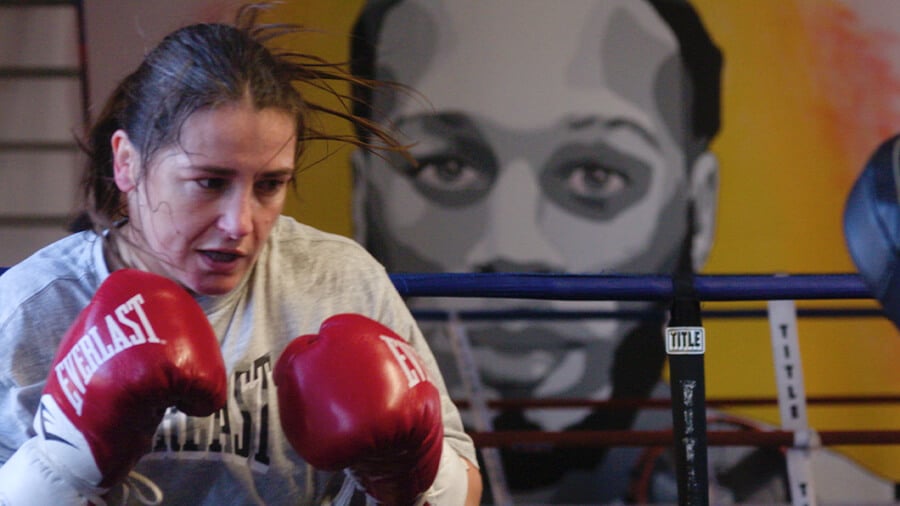
Picture: Katie Taylor training for her fight against Amanda Serrano – Netflix
Jacob: Mike’s health took a bad turn in the run-up to the fight initially scheduled for July. So, with his health being what it was then, it eventually gave you a few more months with the fighters. Did that result in much footage being left on the editing room floor?
Tim: I would say no. It allowed us to step back for a couple of weeks, maybe a month or so, and compartmentalize the show. We decided, along with Everwonder, to include Mike’s health scare in the show. It may have looked like we were with both camps for only two months, but it was actually closer to almost eight. So, the health scare gave us a clear out for the first episode and how it was going to end.
Then, we reset for episodes two and three. But no, the very first thing we filmed was Brownsville when Mike was walking around; it was around April 19th or April 20th. It was chilly here, and you could even see Mike wearing a jacket at some point. It was an easy way to start the first episode and get us going. It was an easy way to start the first episode with the backstories, but no, I don’t think much was left on the editing room floor.
Jackie: Well, I would say this. The reset helped us to streamline what we had shot and what else we needed to film. So it was like, okay… here’s what we’re really missing. The Mike Tyson Punch Out scene with Jake was one of our last shoots.
I think there were a few things that hit the floor for episode three that were more about the lifestyle and more footage outside of the gym, but we just wanted to ramp up the intensity for the fight in episode three. We wanted to make the most of the scenes revolving around them working out and in the gym; that stuff was more important.
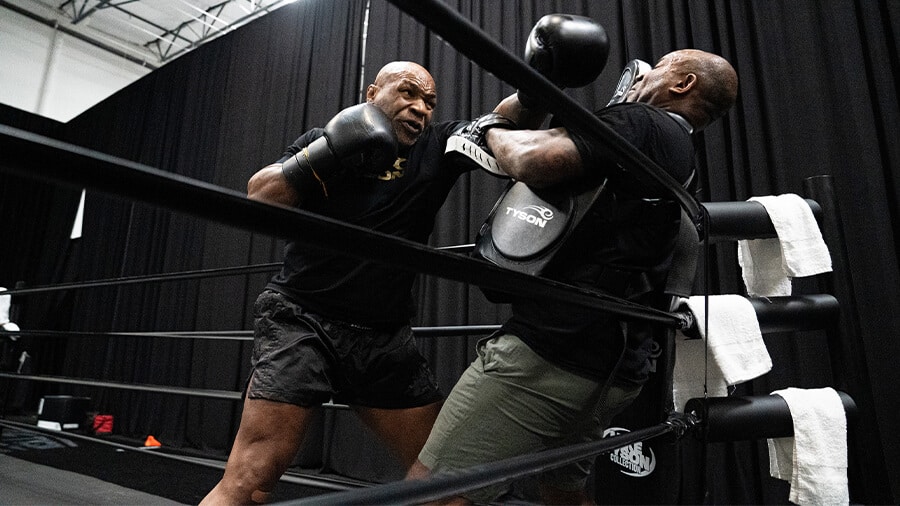
Picture: Mike Tyson training for his fight with Jake Paul – Netflix
Jacob: Even though he’s had cameras in his face most of his life, and he’s grown to live with that, it was interesting to learn how much of an introverted person Mike is.
Tim: He’s very private because he’s not the same way Jake is. Jake doesn’t seek out that kind of interaction. It almost felt like, in a way, that Mike thrives on being recognized now, and I don’t know if it’s the same thing with Jake. I’m unsure if Jake remembers a part of his life when he wasn’t recognized like that. But we both got the vibe that Mike, perhaps at this point in his life differently than when he was younger, just craved that human interaction, too. He loves people recognizing him, and there wasn’t really any tension- well, maybe a little when his daughter was around. Still, he was just a little protective of her because of that scene in Florida, where he was walking around the mall in just two seconds, and it went from zero to sixty.
As we said, we were introducing Jake Paul fans to Mike Tyson, but it’s also more about showing everybody still knows who he is. Some people will never have seen Mike at 19 or 20 years old, knowing people out. As Jackie would say, many people now know Mike as the guy from The Hangover and the movies he’s been in, and now for the edibles and gummies that he’s done… but Mike Tyson, the boxer? That was really who we were trying to reintroduce to the world.
Jackie: I will say this too, like the privacy thing, productions usually have a couple of curve balls, and the ulcer was certainly one of them. The other was just getting Mike on board for us to come out to Vegas and film with him and do X, Y, and Z. But once we had our crew out there, and the cameras rolling, Mike was just switched on. He’s certainly warmed up, and as soon as we’re rolling he’s Mr. Tyson.
Jacob: Jake is a young man, so it’s much easier for him to get into shape and find where he needs to be for a fight. Whereas Mike, given his age and being a retired former champion, it takes a huge effort to get into shape for the fight. What was watching that training process like?
Tim: You know, he’s gone on record saying he had to get in much better shape four years ago for the Roy Jones fight. But after that, he’s kept himself in pretty good shape. The guy still has a six-pack! It’s crazy.
It’s an interesting question because he did have his health scare. Looking back on it now, he may or may not have looked a little bit gassed at times in the gym. So when the ulcer appeared, it was like, oh, okay, that kind of checks out. After that, he eased back into it; we got to spend some time with him as he did lighter work to get ramped up for the fight. But it was impressive by the time he was sparring in the lead-up to the fight.
It helped that they had two-minute rounds versus three. It stopped Mike from getting gassed too quickly. There was always that possibility that all it would take was one moment for Mike to land one big hit, like an uppercut in those early rounds. Jake was afraid of that, so he put on all that weight so he could withstand a classic left hook or right uppercut from Mike, which he was so famous for knocking people out in the early rounds.
Jackie: The one fascinating thing about Mike, and we touched upon this, was that he’s very old-school in how he trains. It was a lot of the same, like getting his massage after every workout he does. So if he’s hitting the mitts, he’ll got and get a massage. When you see him walk around, those are the candid moments we had with him just chatting to the camera as he walks in between each set. That was his way of tuning his brain out.
My father watched the show and is my biggest and worst critic. We had to laugh, as he asked if we repeated the same shots of Mike, as a lot of the training looked the same. But I had to tell him it wasn’t the same, but that’s just what Mike does when he’s working out and training. It’s like four or five different workouts, and that’s his thing.
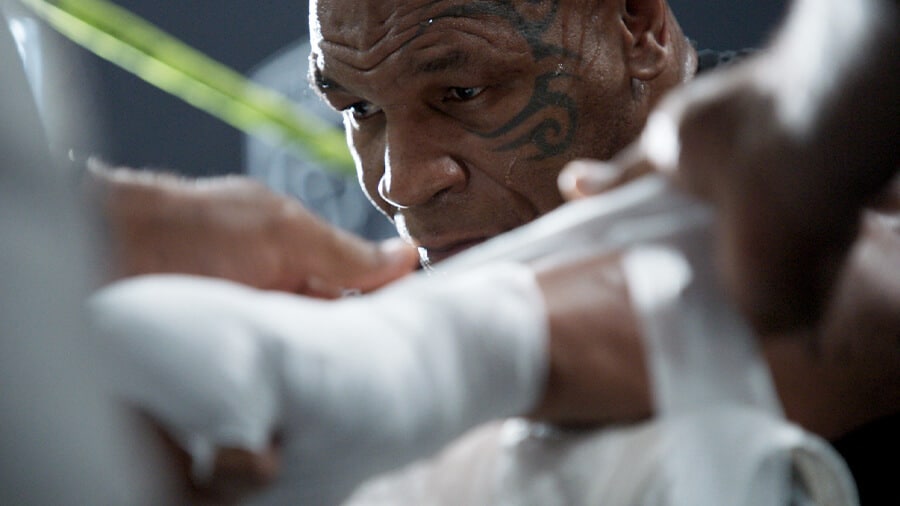
Jacob: What was your biggest challenge in filming the documentary?
Jackie: The ulcer. None of us were expecting it, and it was one of the biggest curveballs we’d ever had as we were full tilt in post. We had a crew and several producers and editors who were already working. It was like, what do we do now? Is Mike even going to come back and fight?
Tim: That was the thing. Was the fight going to get canceled? And to Jackie’s point, we had a crew that would be working with us up to July 20th. But with the curveball, we had to be like, okay, we’re sorry, but we’re going to cut you short here, and then we’d love it if you guys can come back in September and pick it up again. Thankfully, the crew we love working with was okay to hit that pause button, and we were still available to pick it back up in September.
Jackie: There were a lot of factors at play; still, when Jake announced that he was fighting Mike Perry on the 20th, we went and filmed that, and that was cool to get. But during that time, Mike was back in the gym, but that thought was always in the back of our heads. Will he have to pull out of the fight? Please don’t let him pull out of the fight, or at least show up in November, walk out to the ring, and say, “Never mind, I can’t do it,” then we’ll be fine. But that was a tough challenge to manage mentally.
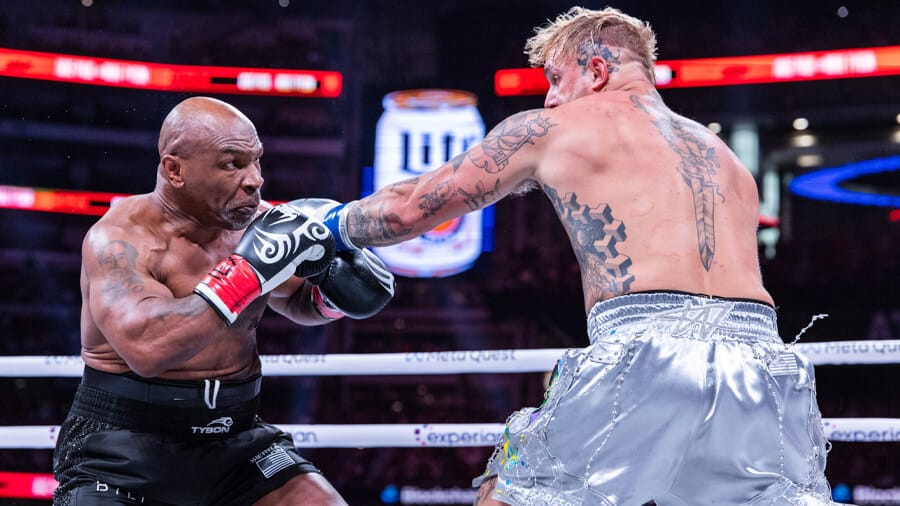
Picture: Mike Tyson and Jake Paul during their fight in Arlington, Texas – Credit: Most Valuable Promotions
Jacob: Considering the time frame you guys had, it was a quick turnaround from all those months of filming to getting the documentary out in time for the event.
Tim: It’s different with streaming now. Like in the old network days on HBO, we could still mix and color those shows on the morning of. We saw the sunrise on those days, but we’d get it out and delivered. Streaming services are a little more complex than that. You can’t quite go up to the line because you’re spreading this worldwide now. It needs to be translated into a hundred different languages. Can you do it? Yes. But they prefer to have a little bit more runway to ensure some technical things don’t go wrong.
Jacob: Where do you feel the future of sports on Netflix?
Tim: In the world we live in now, subscribers drive everything. Live sports, live news, and these things that were once only for big network television- well, the idea that streaming can’t handle that anymore- are slowly disappearing. I think that what will drive people to spend the monthly subscription is, ultimately, the content they have. I can’t speak for Netflix plans, but I can only imagine.
Jackie: I’ll say one thing that really stood out for us, and it stood out for Netflix, too, as they really care about those numbers. They care about the algorithm and subscribers, and we have a ten-day meeting afterward to discuss how many millions of people tuned in. The biggest thing for them was seeing the success of a Countdown-style show airing before this huge live event. For a sports doc to be number one in so many countries was insane for them.
Tim: At one point, the live event was number one, and Countdown was number two. So, having them next to each other in first and second place, not just in the States but in plenty of other countries, was a huge thing, especially for us, because we love doing these kinds of shows. So if that shoulder programming they do to help promote the fight drives people to watch it, that’s a win for everybody.
Jacob: I feel like this is not only a transition into sports, but I’m also questioning whether or not this will be how they transition into other live events, like live music. How long is it before we see a Taylor Swift concert or a BTS concert? The success of these live events will sooner or later transition over to different mediums.
Tim: Oh, it’s going to flip the world upside down. It’s happening; in fact, it’s already happening, and now it’s just a question of how fast it will happen and who will be the big dog on the block.
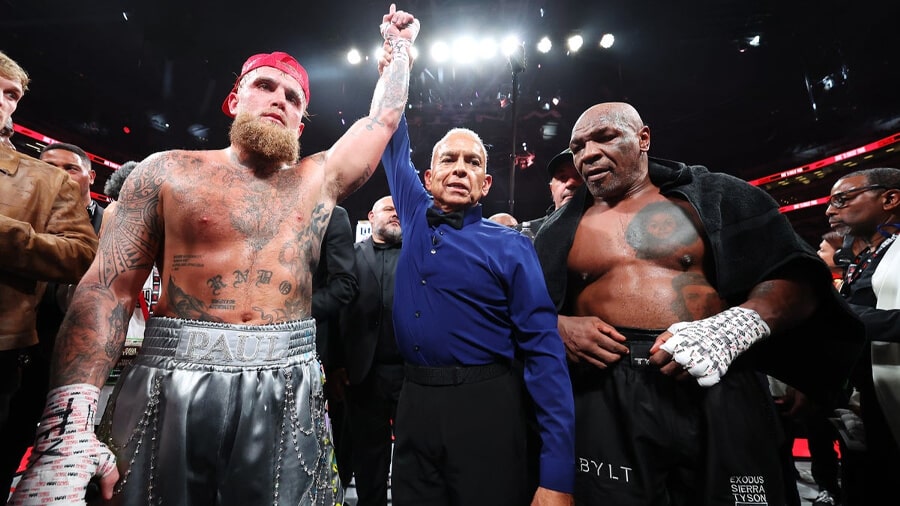
Picture: Jake Paul announced as the winner of the fight by judges decision against Mike Tyson
Jacob: What are you working on next?
Tim: We’re doing a second season of NASCAR: Full Speed. The first season was an extreme success. It’s a sport that was looking to have that Drive to Survive effect that that show had on F1. It did to a degree because we were strategic with its release, which dropped right before the start of the season in February, right before the Daytona 500, which is the NASCAR Super Bowl, and, so, their biggest race comes first.
NASCAR has had plenty of inside-access shows before. Some aired on NASCAR.com, and I believe Peacock had a show a couple of years ago. But when Netflix comes in, they can flex their muscles a little more, and it’s totally different. It’s always about building that comfortable level with the teams and drivers, but it’s shocking how quickly you’re given better access when you’re the Netflix crew.
But we’re not trying to make anything inauthentic. We won’t have you do something you wouldn’t do in your everyday life, like manufacturing rivalries between drivers who are, in fact, friends. So I think that allows you more access with the drivers, with their families, with their teams. After watching the first season, it was much easier to have those conversations about being inside the driver meets, where they were worried we’d be giving away their secrets and stuff like that. There’s a level of trust being built there, and it’s not like they have the first rights to watch it and say, “Hey! Please remove that.” We want to do seasons three, four, and five, so the last thing we want is to upset anyone. We’re all on the same page here. We want to broaden the NASCAR audience.
Jacob: Thanks to social media, most fans know what is going on behind the scenes. So, if anyone is pretending to be friends or rivals on camera, those NASCAR fans are going to see right through that, aren’t they?
Tim: It’s funny because it’s a totally different world for the NASCAR guys. You could get into a fistfight one day, and then, like, five days later, you’re all put together in a bullpen area while you’re getting announced! Not to mention that they all live in Charlotte, North Carolina, and all of the families know each other, like all their kids go to school together.
I’m not gonna say they’re all friends, but they’re involved in each other’s lives to some degree. I remember watching footage the other day from a fistfight between two guys from about two years ago! And now they’re hanging out like it never happened in the first place.
Jackie: They go golfing together on Wednesdays. That makes the show so fun. It has five episodes, they’re in that 40-minute range, and it follows the season’s playoffs. So it’s not like Full Swing or Drive to Survive, which is a little more character-based or race-based. We’re truly following the final ten races of the year. Last season, we had some great, great characters, and some great storylines came from that, and it’s the same again this year, which is in March or April of next year.
Tim: Yeah, the Netflix schedule is a little bit thicker this time in February, so the next iteration of the show, season two, will drop in April.
Did you enjoy Countdown: Jake Paul vs Mike Tyson on Netflix? Let us know in the comments below!

